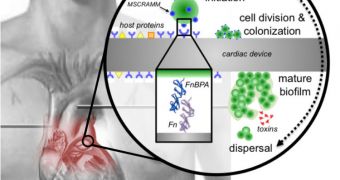Following any type of implant procedure, patients' immune systems are down, making their bodies prime for infection. Some heart implant patients develop a potentially-lethal type of blood infection, and researchers have just recently been able to pinpoint why and how this happens.
Apparently, a certain type of bacterial cells is responsible for the condition. These microorganisms mutate rapidly following the implantation of a pacemaker or similar device, and become able to stick to the actual surface of the medical instrument.
This discovery is extremely important for the millions of people who are currently living thanks to implanted pacemakers. For them, this study comes as a breath of fresh air. The work is detailed in this week's online issue of the journal Proceedings of the National Academy of Sciences.
The US National Science Foundation (NSF) Division of Earth Sciences (DES) funded this investigation. “Geobiologists, key to these results, use atomic force microscopy to study the forces with which bacteria adhere to mineral surfaces,” says DES program director Enriqueta Barrera.
Experts say that the connection with geobiology – which may appear strange at first – is actually fairly strong, since the mechanisms bacterial biofilms use to develop on the surface of implanted cardiac devices are the same other microorganisms used to latch on to minerals.
Biofilms are usually made up of polymers, extracellular DNA, proteins, and polysaccharides, among other cellular products. In some bacteria species, they are tremendously difficult, or even impossible, to penetrate using drugs or other chemicals.
“These scientists have adapted this approach, along with molecular dynamics simulations, to gain a better understanding of the strength with which the proteins of infectious bacteria adhere to cardiac implants,” Barrera explains.
“Such results might have implications for the development of medication to treat this type of infection,” she goes on to say, adding that only patients with bacterial biofilms on their implants go on to develop the full form of the infection.
The study is very relevant for the United States as well, where more than 1 million people receive pacemakers every year. Of this group, about 4 percent (or 40,000 people) develop the infections.
The bacterial culprit is a non-methicillin-resistant strain of the infamous microorganism Staphylococcus aureus. According to the team, SA has only a limited number of genetic variants in its proteins, which enable it to form biofilms more easily.

 14 DAY TRIAL //
14 DAY TRIAL //